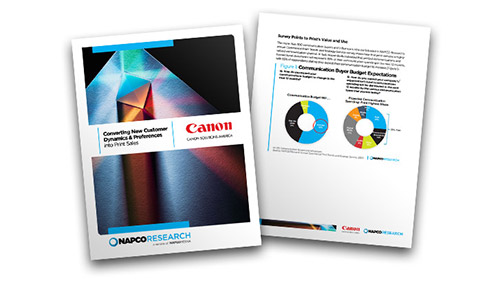Harnessing AI Technology in Print Services
Define Target Audiences and Execute Omni-channel Campaigns
In today’s competitive market, print service providers (PSPs) are increasingly recognizing the importance of targeted marketing and effective campaign execution. With the rise of digital channels and the complexity of consumer behavior, traditional methods of reaching audiences are no longer sufficient. Enter artificial intelligence (AI) technology—a powerful tool that can help PSPs not only define their target audiences more precisely but also execute effective omni-channel campaigns. This can help PSPs charge based on ROI and value-add as opposed to cost-per-print models.
Understanding Target Audiences with AI
1. Data Collection and Analysis
The foundation of effective audience targeting lies in comprehensive data collection. AI algorithms can analyze vast amounts of data from various sources, including social media, website interactions, and customer feedback. By aggregating this information, PSPs can gain insights into consumer preferences, behaviors, and demographics.
For example, AI-driven analytics tools can segment customers based on their buying patterns, interests, and engagement levels. This segmentation allows PSPs to tailor their marketing efforts to specific groups, ensuring that messages resonate with the right people. By understanding their audience in-depth, print service providers can create more relevant and compelling offerings.
With rising postal costs, establishing a well-defined and optimal audience became a crucial way to manage a customer’s budget without sacrificing value and ROI.
2. Predictive Analytics
AI excels in predictive analytics, which helps PSPs forecast future consumer behavior based on historical data. By employing machine learning algorithms, PSPs can identify trends and patterns that inform their marketing strategies. For instance, predictive models can reveal which types of print products are likely to appeal to specific customer segments based on previous purchases and interactions.
This capability allows PSPs to stay ahead of the curve, tailoring their campaigns to meet anticipated demand. Instead of reacting to market changes, they can proactively adjust their offerings, leading to more successful marketing outcomes.
Executing Omni-Channel Campaigns
3. Coordinated Messaging Across Channels
An omni-channel approach ensures that customers receive a seamless experience, whether they interact with a brand online, in-store, or through printed materials. AI technology plays a crucial role in coordinating messaging across these various channels. By analyzing data from different platforms, AI can help PSPs maintain consistency in branding and messaging, ensuring that customers perceive a unified identity.
For example, if a customer engages with a print ad, AI can track their interactions across social media and email campaigns. This allows PSPs to send personalized follow-ups that reference the print ad, creating a cohesive customer journey.
4. Personalized Content Creation
Personalization is a key element of successful omni-channel campaigns. AI can help PSPs create tailored content that speaks directly to the interests and needs of their target audiences. By analyzing customer data, AI algorithms can suggest specific messaging, imagery, and design elements that resonate with different segments.
For instance, if a PSP identifies that a particular demographic responds well to eco-friendly messaging, it can incorporate this theme into both print and digital materials. This level of personalization enhances customer engagement and increases the likelihood of conversion.
5. Dynamic Campaign Optimization
AI technology enables real-time optimization of marketing campaigns. By continuously monitoring the performance of various channels, AI can provide insights into what’s working and what isn’t. For instance, if a print ad is driving significant online traffic, PSPs can allocate more resources to that channel or adjust their messaging based on audience feedback.
This dynamic approach allows print service providers to be agile in their marketing efforts, ensuring that resources are invested in the most effective channels and strategies. With AI, they can swiftly pivot their campaigns to maximize impact.
6. Enhanced Customer Insights
AI’s ability to analyze consumer interactions across channels provides valuable insights that can inform future campaigns. By examining data on customer engagement, PSPs can identify which touchpoints lead to conversions and which ones fall flat. This information can guide the development of future omni-channel strategies, helping providers refine their marketing efforts over time.
For example, if data reveals that customers are more likely to convert after receiving a direct mail piece followed by an email reminder, PSPs can prioritize this sequence in future campaigns. By leveraging AI to continuously improve their understanding of customer behavior, PSPs can enhance the effectiveness of their omni-channel initiatives.
Challenges and Considerations
While AI technology offers significant benefits, print service providers must also navigate certain challenges. Data privacy concerns and compliance with regulations like GDPR are paramount when collecting and analyzing customer data. PSPs must ensure that their data practices are transparent and ethical, building trust with their audiences. Additionally, implementing AI tools may require investment in technology and training for staff. PSPs need to weigh these costs against the potential gains in efficiency and effectiveness.
Conclusion
AI technology presents an invaluable opportunity for print service providers to better define their target audiences and execute omni-channel campaigns. By leveraging data analytics, predictive modeling, personalized content, and real-time optimization, PSPs can create marketing strategies that resonate with consumers across multiple touchpoints. As the printing landscape continues to evolve, embracing AI will be essential for PSPs seeking to stay competitive. By harnessing the power of AI, print service providers can transform their marketing efforts, drive customer engagement, and ultimately enhance their bottom line in an increasingly complex marketplace.
Bonus! Check our thINK Ahead sponsor Boostt.ai. Boostt.ai offers AI-powered marketing and analytics solutions for direct mail, digital ads, email, and integrated cross-channel customer journeys. Boostt.ai is a full-service marketing technology company leveraging the power of AI to predict customer behavior. The platform helps customers strategize and deploy their cross-channel campaigns with a focus on optimally orchestrating them to maximize results and minimize marketing spend.


